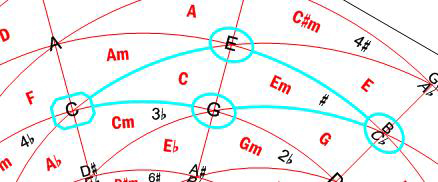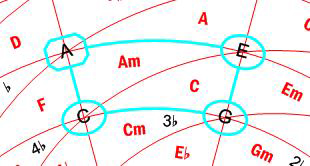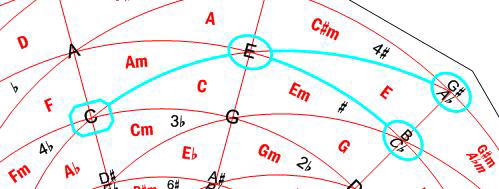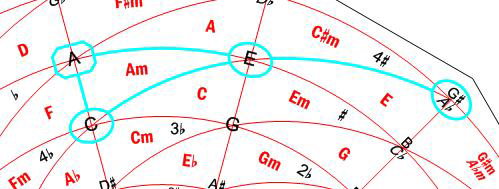|
11. FOUR NOTE CHORDS
Up to now, we have explained the construction and graphic representation of Major, minor, Augmented and diminished chords (in this last case, with 3 and 4 notes). These chords include all possible chords built by superimposing two Major o minor 3rd intervals. And, as we have seen, all of them have a very simple geometric shape on the Harmonic Wheel.
The superimposition of three Major o minor 3rd intervals, gives 8 possibilities. However, the case of three Major 3rds results in an Augmented chord, which has only 3 different notes and has been studied in the last chapter. The other 7 possibilities actually correspond to 4 note chords, but the case of three minor 3rds results in a diminished chord, which has been studied in the last chapter, too. So, we shall go on with the construction and graphic representation of the remaining 6 types of chords. They have been grouped by couples in order to show the existing symmetries. In all cases, the Root of every chord has been marked with  and the rest of the notes with and the rest of the notes with  . .
Now, besides of the 3rd and 5th intervals, a 7th will appear between the first and the last note in each chord. Relating to the symbols used to represent the chords, the most simple as well as universally accepted ones have been chosen. Particularly, the symbol “7” is used to indicate the minor 7th and the symbol “ ” for the Major 7th. From now on, we shall not repeat that the enharmonic notes not following the series of 3rd intervals must be discarded, as it has already been mentioned several times. ” for the Major 7th. From now on, we shall not repeat that the enharmonic notes not following the series of 3rd intervals must be discarded, as it has already been mentioned several times.
A Major 7th Chord is a 4 note chord, built by superimposing a M 3rd, a m 3rd and a M 3rd intervals (in this sequence). Thus, for example, the C Major 7th chord is composed by notes C, E, G, B. This chord is represented by “C ”. ”.
A minor 7th Chord is a 4 note chord, built by superimposing a m 3rd, a M 3rd and a m 3rd intervals (in this sequence). Thus, for example, the A minor 7th chord is composed by notes A, C, E, G. This chord is represented by “Am7”.


Figure 15. Graphic representation of C and Am7 chords on the Harmonic Wheel. and Am7 chords on the Harmonic Wheel.
A Dominant 7th Chord is a 4 note chord, built by superimposing a M 3rd, a m 3rd and a m 3rd intervals (in this sequence). Thus, for example, the G Dominant 7th chord is composed by notes G, B, D, F. This chord is represented by “G7”. It is worthwhile to point out that, in this chord, a d 5th (tritone) is formed between the 3rd and the 7th of the chord (in the example, between B and F).
A half-diminished Chord is a 4 note chord, built by superimposing two m 3rd and one M 3rd intervals (in this sequence). Thus, for example, the B half-diminished chord is composed by notes B, D, F, A. This chord is represented by “B ”. It is worthwhile to point out that, in this chord, a d 5th (tritone) is formed between the root and the 5th of the chord (in the example, between B and F). ”. It is worthwhile to point out that, in this chord, a d 5th (tritone) is formed between the root and the 5th of the chord (in the example, between B and F).
Figure 16. Graphic representation of G7 and B chords on the Harmonic Wheel. chords on the Harmonic Wheel.
An Augmented, Major 7th Chord is a 4 note chord, built by superimposing two M 3rd and one m 3rd intervals (in this sequence). Thus, for example, the C Augmented, Major 7th chord is composed by notes C, E, G , B. This chord is represented by “C+ , B. This chord is represented by “C+ ”. ”.
A minor, Major 7th Chord is a 4 note chord, built by superimposing one m 3rd and two M 3rd intervals (in this sequence). Thus, for example, the A minor, Major 7th chord is composed by notes A, C, E, G . This chord is represented by “Am . This chord is represented by “Am ”. ”.


Figure 17. Graphic representation of C+ and Am and Am chords on the Harmonic Wheel. chords on the Harmonic Wheel.
|